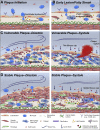Atheromas feel the pressure: biomechanical stress and atherosclerosis
- PMID: 20558573
- PMCID: PMC2893643
- DOI: 10.2353/ajpath.2010.090615
Atheromas feel the pressure: biomechanical stress and atherosclerosis
Abstract
Atherosclerosis, a chronic vascular disease, is the underlying cause of over half the deaths in the United States each year. Variations in local vascular hemodynamics predispose select sites in the vasculature to atherosclerosis, and the atherosclerotic lesions, in turn alter the biomechanical functioning of the local microenvironment, the consequences of which are not well understood on a molecular level. Further progress in the field of atherosclerosis will require an understanding of the relationship between biomechanics, the tissue microenvironment, and the cellular and molecular response to these factors. This review summarizes this field, particularly within the context of the vascular smooth muscle cell.
Figures


Similar articles
-
Do vascular smooth muscle cells differentiate to macrophages in atherosclerotic lesions?Circ Res. 2014 Sep 12;115(7):605-6. doi: 10.1161/CIRCRESAHA.114.304925. Circ Res. 2014. PMID: 25214571 Free PMC article. No abstract available.
-
Role of thrombin in the pathogenesis of atherosclerosis.J Cell Biochem. 2019 Apr;120(4):4757-4765. doi: 10.1002/jcb.27771. Epub 2018 Sep 30. J Cell Biochem. 2019. PMID: 30269382 Review.
-
Atherosclerosis: nexus of vascular dynamics and cellular cross talks.Mol Cell Biochem. 2022 Feb;477(2):571-584. doi: 10.1007/s11010-021-04307-x. Epub 2021 Nov 29. Mol Cell Biochem. 2022. PMID: 34845570 Review.
-
Mitochondrial DNA damage, oxidative stress, and atherosclerosis: where there is smoke there is not always fire.Circulation. 2013 Aug 13;128(7):681-3. doi: 10.1161/CIRCULATIONAHA.113.004531. Epub 2013 Jul 10. Circulation. 2013. PMID: 23841982 No abstract available.
-
Emerging Concepts of Vascular Cell Clonal Expansion in Atherosclerosis.Arterioscler Thromb Vasc Biol. 2022 Mar;42(3):e74-e84. doi: 10.1161/ATVBAHA.121.316093. Epub 2022 Feb 3. Arterioscler Thromb Vasc Biol. 2022. PMID: 35109671 Free PMC article. Review.
Cited by
-
Rab5a‑mediated autophagy regulates the phenotype and behavior of vascular smooth muscle cells.Mol Med Rep. 2016 Nov;14(5):4445-4453. doi: 10.3892/mmr.2016.5774. Epub 2016 Sep 26. Mol Med Rep. 2016. PMID: 27666726 Free PMC article.
-
Downregulation of miR-4284 can Inhibit the Apoptosis of Human Arterial Smooth Muscle Cells (HASMCs) in Arteriosclerosis Obliterans (ASO).Comb Chem High Throughput Screen. 2024;27(8):1140-1148. doi: 10.2174/1386207326666230818092922. Comb Chem High Throughput Screen. 2024. PMID: 37594113
-
PDGF-mediated autophagy regulates vascular smooth muscle cell phenotype and resistance to oxidative stress.Biochem J. 2013 May 1;451(3):375-88. doi: 10.1042/BJ20121344. Biochem J. 2013. PMID: 23421427 Free PMC article.
-
Stochastic modulations of the pace and patterns of ageing: impacts on quasi-stochastic distributions of multiple geriatric pathologies.Mech Ageing Dev. 2012 Apr;133(4):107-11. doi: 10.1016/j.mad.2011.09.001. Epub 2011 Sep 22. Mech Ageing Dev. 2012. PMID: 21963385 Free PMC article. Review.
-
Risk factors and clinical consequences of side branch occlusion in left anterior descending bifurcation percutaneous coronary intervention: a validation study of the V-RESOLVE score.Front Cardiovasc Med. 2025 Jul 18;12:1648244. doi: 10.3389/fcvm.2025.1648244. eCollection 2025. Front Cardiovasc Med. 2025. PMID: 40756602 Free PMC article.
References
-
- Vanepps JS, Vorp DA. Mechano-pathobiology of atherogenesis: a review. J Surg Res. 2007;142:202–217. - PubMed
-
- Mayr M, Hu Y, Hainaut H, Xu Q. Mechanical stress-induced DNA damage and rac-p38MAPK signal pathways mediate p53-dependent apoptosis in vascular smooth muscle cells. FASEB J. 2002;16:1423–1425. - PubMed
-
- Stegemann JP, Hong H, Nerem RM. Mechanical, biochemical, and extracellular matrix effects on vascular smooth muscle cell phenotype. J Appl Physiol. 2005;98:2321–2327. - PubMed
-
- Li L, Couse TL, Deleon H, Xu CP, Wilcox JN, Chaikof EL. Regulation of syndecan-4 expression with mechanical stress during the development of angioplasty-induced intimal thickening. J Vasc Surg. 2002;36:361–370. - PubMed
-
- Brown TD. Techniques for mechanical stimulation of cells in vitro: a review. J Biomech. 2000;33:3–14. - PubMed
Publication types
MeSH terms
Grants and funding
LinkOut - more resources
Full Text Sources
Medical

